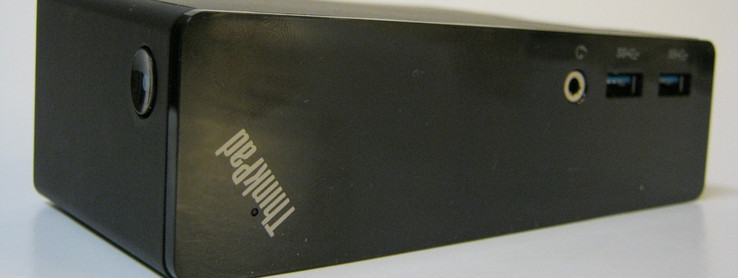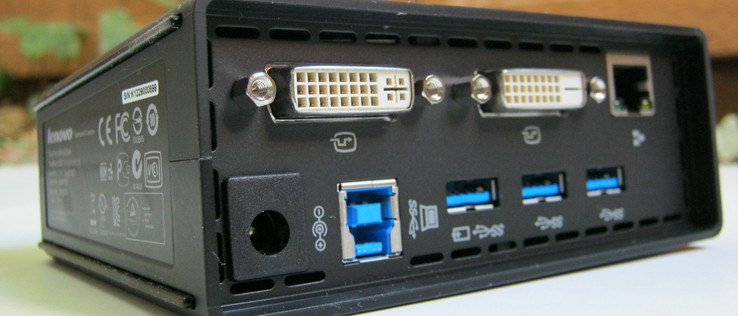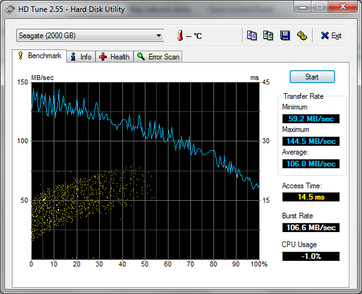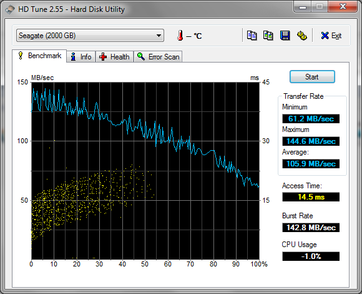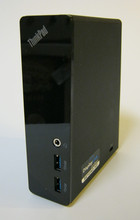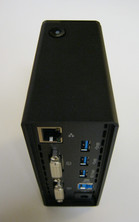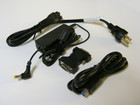USB Docking Station in Review: Lenovo USB 3.0 Dock 0A33970
The core functionality of the ThinkPad USB 3.0 Dock (0A33970) is best described by Lenovo’s Think & Design Director himself: “to enable the customer to connect to their notebook using a single cable, yet have access to all of their peripherals.”
With the aid of drivers and DisplayLink’s DL-3900 chipset (as found in the Fujitsu USB 3.0 Replicator PR08), the docking station transforms a USB 3.0 port into a hub of both display outputs and multiple USB 3.0 ports. ThinkPad models that conspicuously lack dedicated docking ports will be able to benefit the most from the connectivity options provided by the dock. Although the unit should be compatible with any notebook running Windows software, the official ThinkPad compatibility list can be seen here.
Specifications (official manual)
- 1x USB 3.0 upstream input for connecting to notebook. The dock is compatible with USB 2.0/1.1, though performance will be stunted. A USB 3.0 cable is provided.
- 2x DVI output (1x DVI-I, 1x DVI-D), each up to 2048x1152 or 1920x1200 pixel resolution at 60 Hz. A DVI-VGA adapter is provided.
- 5x USB 3.0 (3x rear, 2x front). Sleep-and-charge is enabled for one port on the rear.
- 1x Gigabit Ethernet (10/100/1000 Mbps) with full support for ThinkVantage Access Connections.
- 1x 3.5 mm headset/microphone combo jack. The original 3.5 mm jack on the notebook is not disabled when using the dock.
- 1x Kensington Lock
- Official support for Windows XP/Vista/7/8. Support for other platforms is not explicitly stated.
The docking station sets up similarly to most PC peripherals on first use – simply connect the docking station to a required external power source, an available USB 3.0 port, and install the drivers from the included DVD. Users can download the driver software directly from Lenovo should the notebook lack an optical drive, such as our X1 Carbon test unit. The Carbon in particular has notoriously dropped a few physical ports (RJ-45, HDMI, USB/eSATA) compared to earlier X1 models, so the docking station is practically ideal for ultrabooks that have sacrificed key connectivity features for size.
After setup, we test DVI performance by cloning the display onto an external monitor (HP w2408) capable of 1920x1200 pixel resolution. However, since the internal X1 Carbon display is only capable of a resolution of 1600x900 pixels, the mirrored external will scale accordingly with borders. Auto-detect is also on the slow side at about 10 seconds before the external monitor is recognized. Subjectively, SD videos play without any noticeable frame drops and input lag is within the typical 30 ms window.
720p videos on Youtube will play fairly smoothly on the external display as well, but slight stutters do occur. Expectedly, this becomes more prominent in 1080p playback and is likely the limitation of the docking station as the video on the internal X1 Carbon display runs comparatively more consistently. The stutters are not significant enough for the 1080p videos to be unwatchable, though the lack of smooth playback can be irritating to viewers during fast-moving scenes.
CPU Performance
Streaming video through DVI via USB will require encoding and, thus, processing time from the CPU. We compare CPU load between full screen playback of SD content on the internal display and then on the external display. Here, the high-end 2.0 GHz dual-core i7-3667U experiences a total average CPU load of only 7 percent through its internal display compared to a 14 percent average through the external. 1080p playback will increase CPU load to about 24 percent and 29 percent on the internal display and external display, respectively. DisplayLinkManager.exe maintains a CPU activity between 5 and 11 percent, which roughly corresponds to the differences in CPU loads between internal and external playback.
To test if running on only the external display would be detrimental to overall CPU/GPU performance, we ran Cinebench 11.5 64-bit on the external and internal displays separately on a matching resolution of 1440x900 pixels. The final CPU score was 2.9 points regardless of monitor setup, which hints that any CPU time required by the USB 3.0 dock can be considered negligible in affecting everyday tasks. OpenGL performance will take a miniscule hit from a recorded 15.16 FPS to 14.79 FPS on the external.
3D and Games
We test DirectX compatibility with Starcraft 2, which includes native support for DirectX 9 for Windows. Frame rates at the suggested levels for an HD 4000 GPU are smooth and with no hiccups, but mouse lag is slightly higher than normal. Mouse latency will decrease if the 'Reduce Mouse Lag' option is active, but the screen will unexpectedly flicker at random and frequent intervals during gameplay. In any case, the Blizzard title runs just fine in full screen.
For OpenGL, we use the freeware title AssaultCube. Launching the program will unfortunately result in a blank or garbled screen, though in-game music and sound effects can be heard. In contrast, the game runs flawlessly when launched directly on the internal display only.
The Fujitsu PR08 had problems launching both DirectX and OpenGL programs on the internal display without first uninstalling the DisplayLink driver. No such issues occurred during testing with the Lenovo USB 3.0 Dock.
USB 3.0
The Lenovo dock wastes no time with USB 2.0 and offers only USB 3.0 across the board. Plug and play works flawlessly as one would expect without any detriment to performance or transfer rates.
Transfer rates with a tested USB 3.0 Seagate external HDD return an average of 105.9 MB/s without the Lenovo dock and 106.0 MB/s with an external dock and a 1080p video playing simultaneously, according to HD Tune. Users should not be able to notice any significant performance hits from using the USB ports on the Lenovo dock. The burst rate without the dock is almost 40 MB/s faster than with the dock included, but this particular data will easily fluctuate throughout multiple runs regardless of whether or not the dock is in use.
Temperature
During SD video playback, we measured an operating temperature of 36oC (97oF) with an ambient temperature of 25oC (77oF). The power adapter ran even cooler than the dock itself at a measured 33oC (91oF). Expect the dock to become warm to the touch during typical use, though never at alarming temperatures.
Verdict
The Lenovo USB 3.0 Dock offers the common range of connectivity options in a package that is practically plug and play. It's size, style and quality will certainly match side-by-side with any ThinkPad and its compactness is a great selling point for those who dislike the large and comparatively clunky docking stations. As an added bonus, DirectX games should play better than expected, although not free from the occasional hiccups.
On the other end of the spectrum, the USB 3.0 Dock lacks dedicated HDMI and DisplayPort options and OpenGL support. The dual video-out capability is perhaps the key feature of the dock, so users who know they will not be taking advantage of the DVI outputs will essentially be purchasing an overvalued 5-port USB 3.0 hub. Those who want the the additional video outputs without the added USB 3.0 ports can opt for the Lenovo USB 3.0 to DVI/VGA adapter instead.
The USB 3.0 Dock is currently available for $179 and can be purchased directly from Lenovo's online store. The unit is less expensive compared to the manufacturer's dedicated docking stations and its simple flexibility from a single USB 3.0 port is enough for us to recommend the dock as an alternative to the more traditional Lenovo docks.


